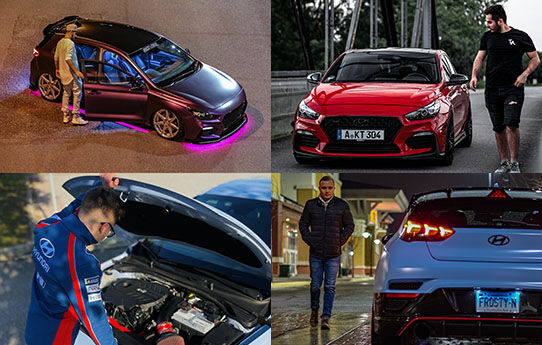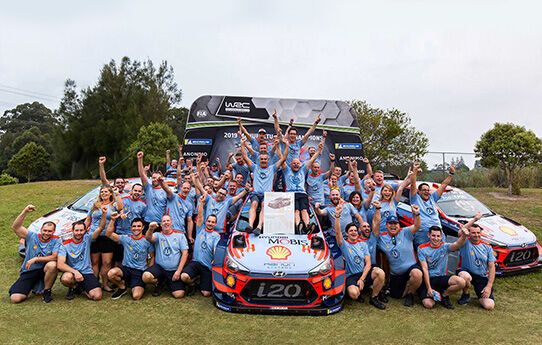Motorsports-inspired Technology into
Production Model ‘Rolling Lab’
29 OCT 2021
By Sujin Lee
Can Hyundai Motor Company build a midship sports car? Some might doubt, while some might already be waiting for its reveal. But, at least, there will be no one who would say it’s just a mere fantasy - and it’s because there is the RM project.
29 OCT 2021
By Sujin Lee

Hyundai’s RM project is a ‘Rolling Lab’ that acts as a bridge between racing cars and N production models. Its purpose is to test and develop high-performance technologies and to showcase the brand’s technological potential. In the automotive industry, such a car is often referred to as a ‘Halo Car’. This is because it has a ‘halo effect’ on mass-produced models, and furthermore, creates a dynamic and positive image for the brand. The RM Project, which started with the RM14 revealed in 2014, worked as a testbed for various high-performance technologies, laying the foundation for N Performance.
RM, The Racing Midship
The RM project, which started in 2012, aimed to realize the extreme driving performance that Hyundai had not attempted before. RM stands for ‘Racing Midship,’ and it was revealed at the 2014 Busan Motor Show after two years of preparation. The first model, the RM14, was a midship model that looked just like a Veloster; a 300 HP 2.0L theta turbo engine sat where the rear seats used to be. It was used as a test car to develop and verify new technologies as well as the characteristics of a high-performance car.

Hyundai dubbed the hybrid lightweight body structure - or HLBS - for the RM15, and revealed the RM16 with an electric supercharger with increased responsiveness. Then in 2019, the RM19 was revealed with the drivetrain of a TCR race car housed at the center of the body. The latest RM20e has the same body as the RM19, but it is the first all-electric vehicle with an electric motor.

Why Midship?
Where to put the engine or which wheel drive to choose is a very important question to answer that could determine the overall characteristics of a car. Most general passenger cars are FF (Front Engine Front Drive), in which the engine is placed on the front of the body and uses a front-wheel drive system. On the other hand, FR (Front Engine Rear Drive) in which the engine is in front and the rear wheels are driven is widely used in luxury cars and high-performance cars. The front wheel is for steering while the rear wheel is solely for driving, which is advantageous in terms of performance.



‘Midship’ literally means the engine is placed at the center of the body (between the passenger seat and the rear wheel) and is driven by the rear wheels. Agility is heightened when you place the engine - the heaviest component of a car - close to the center of the body; but of course, you will have to give up the back seat, then. This is why it is difficult to find a midship layout in a regular passenger vehicle. Nevertheless, sports cars, especially supercars, use midship because it is advantageous for sports driving. A small body with a midship structure, specially designed for the RM project, is a perfect choice for Hyundai because it will serve the purpose of testing its technologies on a vehicle a little too sensitive to drive. This is why the project was named Racing Midship, RM.

Technologies for mass-produced cars
The technologies verified through the RM project are applied to various Hyundai models, including N, to enhance driving performance. The most notable example is the Corner Carving Differential (e-LSD), which was first introduced on the i30 N in 2017 and is currently installed in most N models. The e-LSD, which has been tested through RM16, is a device that electronically controls the torque of the left and right wheels. It suppresses understeer caused by the turning difference between left and right wheels when going through tight corners. By doing so it reduces slip on extremely slippery roads and aids fast acceleration.

The 8-speed wet DCT (Dual Clutch Transmission) is also a technology that has been tested through the RM19. Among the N models, it was first introduced in the Veloster N in 2020, and has since been applied to the i30 N, Kona N, and Avante N (Elantra N). For reference, the 8-speed wet DCT was developed for high-performance engines. Unlike the conventional dry transmission without a high permissible torque limit, a wet clutch with oil cooling can handle higher torque.

Exhaust sound design, which has been continuously tested since RM16, is also a technology housed in Hyundai’s latest models. In high-performance models, sounds that arouse emotional excitement is an important factor. In the latest N model, Avante N (Elantra N), the aforementioned technology has been further developed as N Sound Equalizer (NSE), which even provides the exhaust sounds of a TCR race car sound.
In addition, the roll cage used in racing cars was applied to the rear part of the body in the form of a simplified partial roll cage in the RM project. This increases rigidity and minimizes distortion of the vehicle body when driving. The rear brace bar of Avante N (Elantra N) is derived from this. The rear spoiler, which is a representative aerodynamic part, is also notable. Hyundai’s aerodynamic performance has been continuously upgraded through the RM project. Although the rear spoilers on all N models might look similar, every rear spoiler is optimized through numerous experiments to complement each model’s performance.

Carbon outer parts, which have been used since RM15, have also been continuously researched on to reduce weight and improve rigidity for mass production. The i30 N Project C, which was introduced in 2019, has carbon hood and bucket seats, reducing the weight by about 50 kg. For reference, 600 units of the i30 N Project C produced were sold out for the first time in Hyundai Motor’s C-segment in Europe.
The aforementioned are only a few of the core technologies derived from the RM project. As described, the ‘Rolling Lab’ plays a key role in allowing us to predict new technologies to be applied in future production models.


Bringing Motorsports Technology onto Roads
Hyundai’s brand image in the global automobile market is consistently being refurbished thanks to its active role in the motorsports field, amplifying this trend through N brand. People are enjoying and experiencing the pleasure of driving through N, cars that have been developed directly from race cars.

The RM project, referred to as the ‘Rolling Lab’, has played a very important part in Hyundai’s high-performance roadmap. Just as quenching and tempering complete great swords, Hyundai has and will continue to broaden its high-performance model line-up That serves as both a daily car and sports car. What kind of future will the RM project lay out in its next phase? The new slogan of the N brand, ‘Never just drive.’, demonstrates the brand’s dream and willingness to pursue the fuN of driving at every moment even in the era of electric vehicles. RM Project will continue to play an active role as the forerunner of that dream in the future.
By Sujin Lee, automobile critic Excited about the 1991 establishment of the first domestic auto mania magazine 〈Car Vision〉, I sent a series of long letters there that led to an unexpected hire. 27 years have passed since then, the years of plowing through the writing struggles of an auto journalist. After becoming an editor for 〈Car Vision〉, I came to my current position as the Editor-in-Chief for 〈Car Life〉. My recent interests include cutting-edge techs like electric cars, connected cars, and autonomous driving, but the ‘otaku’ in me doesn’t want internal combustion engines to disappear either.
More from N-ZINE









